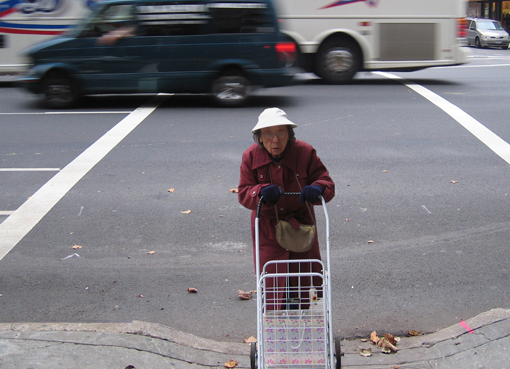TA Urges DOT to Expand Safe Streets for Seniors
 TA recommends longer crossing times than DOT’s Safe Streets for Seniors program currently employs.
TA recommends longer crossing times than DOT’s Safe Streets for Seniors program currently employs.Older pedestrians are probably the city’s most vulnerable street users, much more likely to die in traffic collisions than younger New Yorkers. It’s a public health concern that extends beyond fatality statistics: Fear of the street keeps seniors cooped up inside, constricting their independence and contributing to higher rates of depression.
With New York’s 65-and-older population projected to nearly double to 1.35 million by 2030, last year DOT launched its Safe Streets for Seniors program to tackle the worst problem areas for the city’s elderly. Targeting 25 zones with high rates of senior pedestrian fatalities, the DOT pilot is the first of its size for a city transportation agency in the U.S. But is it doing enough?
In a report released yesterday, Transportation Alternatives pushed for an expanded program that better reflects where seniors actually walk. The main thrust of "Walk the Walk" [PDF] is that the safety zones should cover areas with big senior populations in addition to areas where fatal crashes have occurred. Its recommendations lay out a strategy to boost not just the safety of older New Yorkers, but their access to common destinations like grocery stores, parks, and houses of worship.
TA highlighted these key findings in its press release:
- The fatality rate of senior pedestrians is 40 times greater than that of child pedestrians in Manhattan.
- Of 10 high-density senior census block groups in the Lower East Side, only one was included in a Safe Streets district.
- Safe Streets for Seniors pedestrian improvement areas do not
clearly provide safe connections from high senior density housing to
the destinations seniors like to visit the most, such as stores with
fresh produce.
DOT is considering expanding its program beyond the current 25 pilot areas, and may weigh additional criteria when selecting the next round of target zones. “We are constantly looking for ways to improve the safety of children and seniors on our streets, which is why we launched the Safe Routes to Schools and Streets for Seniors programs," said DOT’s Seth Solomonow in response to the report. "These initiatives, which increase crossing time at intersections, improve crosswalks and expand pedestrian space, are the largest traffic-calming initiative of their kind anywhere in the nation.”
